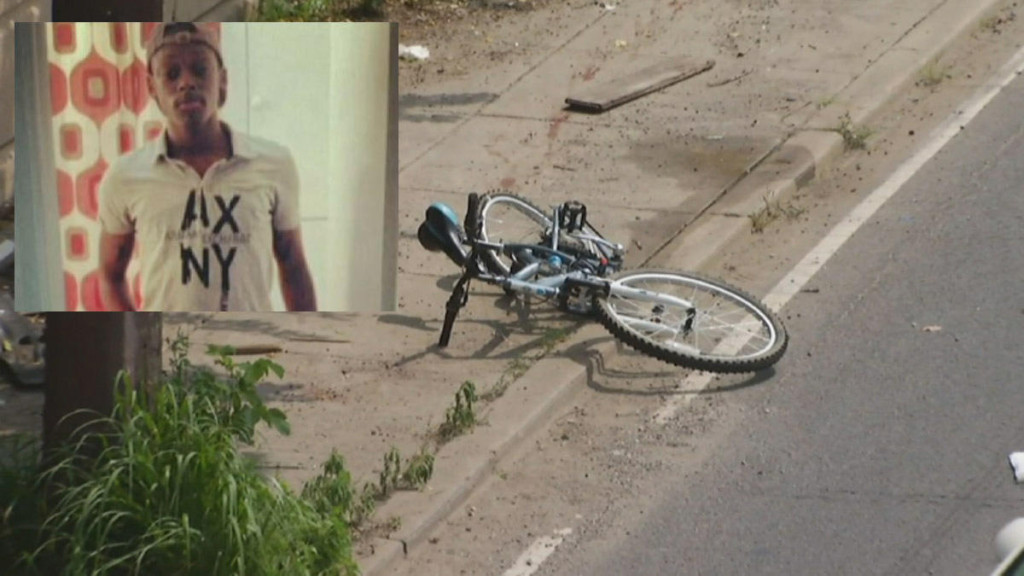
Image: NBC Philadelphia
Lakeya Tillman contacted the Bicycle Coalition of Greater Philadelphia on October 23 with a heart-wrenching story.
Her step-son, Tyrone Tillman, had been killed by a hit-and-run driver earlier this year, and while her message was one of thanks “for bringing awareness to all the reckless drivers in the city with no regard to cyclists,” what she needed was our help.
The section of North Second Street near Hunting Park, where Tyrone was killed, is exceedingly dangerous for road users and something needed to be done to make sure this did not happen again.
“This is just not for our son but for a community,” she said. “Tyrone Tillman’s death was not in vain.”
A few days later, Bicycle Coalition staff Randy LoBasso, John Boyle, Waffiyyah Murray, and Bob Previdi met with Lakeya and Tyrone’s mother at our office at 1500 Walnut Street. During that meeting, we were told many of the devastating facts of Tyrone’s death, as recounted in a Philadelphia Inquirer story:
Police would tell his father a driver hit him, stopped her car to look at the stricken boy, and sped off after a passenger in her car told her to leave.
Two people in another car wrote down the woman’s license plate number, called 911, and followed her until police arrived. Two more stayed with T-Jay as he lay dying in the street.
Allegedly, the person who hit and killed Tyrone attempted to remove the license plate from their car after the crash occurred. The suspect was taken into custody and then released.
An arrest was later made, on September 25.
After our meeting, we began speaking to several officials in numerous ranks of government. Since the crash occurred, an evaluation has been done to justify calming measures. But, as of November 5, the city had not received a petition from the community, which is a required step in order to implement traffic calming measures.
That section of street, which is relatively empty of residential housing for a city block, is regularly used as a place where people drive excessively fast, and even hold drag races.
This is of significance because there are so few community members living around that particular area.
There’s a school along the street, too, which makes this a particularly pressing issue. And we’ve made several recommendations to the Streets Department, many of which they are currently considering. We believe the most likely of those recommendations, which are available below.

This is the existing street.

Our recommendation
We’ve also told the city that in the meantime, the street needs speed cushions to slow down existing traffic, and to stop reckless drivers from holding unlawful races.

This is a speed cushion
The recommendations for traffic calming measures in these cases often come from a Councilperson’s office, and can start with an RCO or BID. The Bicycle Coalition contacted Councilwoman Sanchez’s office (Sanchez represents the area), who should be contacting local stakeholders for their input, as well.
We are continually working on this issue and will keep our members updated as this progresses.

Has any kind of area traffic survey been done to show the change won’t significantly hinder traffic flow in the direction to be eliminated (North) in the area? Really, such terrible tragedies are a sociological issue, and I would love to know the profile of the person who committed the crime. The real issue here may very well be getting everyone some sort of job and involvement in society to reduce anger and frustration. Just how fast was she going, and why? And just where was the stricken boy in relation to the car lanes? Was he riding in an area where he could not be seen, or riding across the street, in a situation where he underestimated the speed of the car? Maybe a crossing signal would be a solution. What really led to the crash? In the meantime, unless there are plenty of lanes in the area for the vast majority of cars and trucks operated by responsible people, this needs to be considered from a broader perspective. If all we do is eliminate car lanes to add bike lanes, the end result could be increased driver frustration due to congestion, and the recruitment of good drivers into the ranks of “speeding traffic.” It’s pretty irksome that after the change there will be a bike lane in each direction, but a car lane in only one. How about adding a bike lane to the present situation with opposing traffic lanes by narrowing them slightly? As usual , bike/pedestrian issues are considered, but no auto traffic interests. Not all auto and truck drivers are bad guys with little consideration for safety. But, we all are to be punished. . .
John, what you’re not acknowledging is that statistically, more and safer bike infrastructure reduces automobile traffic, which in itself reduces the need for more standard lanes. Congestion can also lead to alternative forms of transit when available, such as mass transit or bikes. Also, adding car lanes actually does not have the intended effect of reducing traffic. So more and more car lanes, which lead to higher speeds, and more danger for pedestrians and cyclists, don’t even solve the problem they are meant to solve!
” As usual , bike/pedestrian issues are considered, but no auto traffic interests.”
!
I think the fact that a speed bump design is being shown in addition to the bike lane design shows that auto traffic interests ARE being considered. We don’t know the factors that caused the crash, but statistics show that a reduction in speed/and adherence to speed limits make the roads safer for all of us. A speed bump certainly is a cheaper solution than “getting everyone some sort of job and involvement in society to reduce anger and frustration”. Also, think about what you are saying. Is saving a couple minutes on your commute really worth someone else dying?